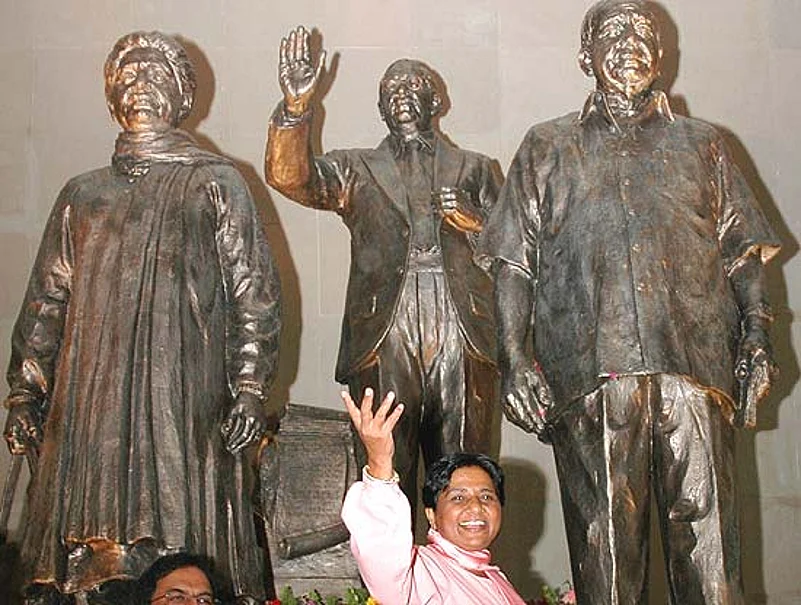In trying to be bigger than life, Mayawati may finally have pushed too hard. Even the Dalits are regarding her obsession with erecting statues of herself and other Dalit icons across the state at a stupendous cost of Rs 5,000 crore as a waste of public funds. Her loud display of personal wealth and property is being seen as unbecoming of a leader of a party which is dedicated to the poor and the downtrodden. And now, two members of the core group that founded the BSP along with Kanshi Ram have come out against Mayawati.
Raj Bahadur and R.K. Chaudhari were part of the tireless group around Kanshi Ram which played a pivotal role in building the BSP in the late ’80s. Today, neither is in the party—like other key figures from those early years. Mayawati, they lament, may have “risen in status and stature, but the party’s ideology and mission, as articulated by Kanshi Ramji, have taken a backseat”.
Advertisement
Raj Bahadur, now 66, retired prematurely from the Post and Telegraph (P&T) Service in 1987 to join the BSP. Today, he is disillusioned with the manner in which Mayawati is running the party. “The BSP,” he says, “rose to power, but Mayawati’s inaccessibility and her dictatorial style diminished the party nationally. A party that once boasted of MPs in Punjab, Haryana and Madhya Pradesh is now limited to UP.”
Chaudhari, who abandoned his legal practice to join the BSP, has fond memories of Kanshi Ram, his frugal lifestyle and accessibility, in sharp contrast to Mayawati’s. “In 1985,” he recalls, “Kanshi Ramji visited Lucknow, walking for hours, talking to slum-dwellers along the Ghaziuddin Haider canal, the city’s major sewage drain.” But Mayawati, he says, has lost that sense of humility. “What has led Mayawati to believe that inaccessibility is some sort of virtue? Apparently, she does not seem to realise that her arrogance and isolation are taking her away from those whom the BSP founder had cultivated and endeared to bring the party to power.”
Advertisement
Cohabitation with the BJP, with which it formed governments in 1995, 1997 and 2002, Raj Bahadur feels, made the BSP lose its bearings. “The BJP-RSS combine,” he says, “threatened by the Samajwadi Party-BSP government that came to power in 1993, engineered a rift in the alliance by throwing the bait of chief ministership at Mayawati.” She withdrew support to the Mulayam Singh Yadav-led SP-BSP coalition in 1995.
According to Chaudhari, with Mayawati at the helm, the BSP might have made a few short-term gains, “but the party undisputedly incurred long-term losses, particularly after Kanshi Ramji got bogged down with his ailments and Mayawati usurped all his authority.” Convinced that the party had gone astray from the path shown by Ambedkar and Kanshi Ram, both Bahadur and Chaudhari are strongly of the view that today the BSP had etrayed its own supporters on all counts—be it employment for Dalits, security, health, scholarships to scheduled caste students or the implementation of NREGS.
On the construction of memorials and installation of her own statues, they feel as long as there was going to be one big memorial, it was fine, but now it seems that the idea was only to enhance construction activity involving huge kickbacks. “There was nothing wrong in the installing of Kanshi Ramji’s statues,” says Chaudhari, “but the BSP founder’s name is now being misused only to justify the obsession for her own statues, which only reflects her megalomania.”




















